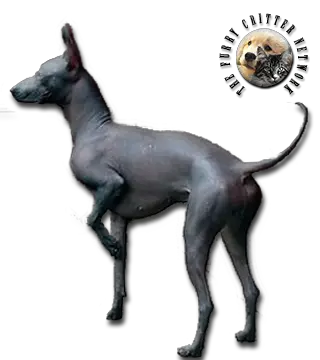Breed Standard
Head: Lupoid in structure. Broad skull. Stop not very pronounced. Straight nosebridge. Tight-lipped. Dentition almost always incomplete (missing one or all premolars and molars). Nose matches coat color.
Ears: Medium in length, nearly pointed at the tips. Erect in action. Lying back against the head at rest.
Eyes: Medium-sized, slightly almond-shaped. Ranging from black to brown to yellow, depending on coat color.
Body: Medium-sized. Domed topline. Withers not very pronounced. Chest of good width. Ribs slightly well-sprung. Straight back. Rounded, solid croup.
Tail: Set on low. Fairly thick at the base, tapering toward the tip. In action, raised in a curve above the topline but not curled. At rest, hanging down with a slight upward hook at the tip.
Hair: Vestiges of hair allowed on the head, lower legs, and tip of the tail. Sparse hair on the back also allowed.
Coat: Hair is black in the black variety. In other varieties, hair is slate black, elephant grey, bluish-grey, any other shade of grey, or dark brown to light blond. All colors solid or with pinkish spots anywhere on the body.
Size: Large: 50 to 60 cm. Medium: 40 to 50 cm. Small: 25 to 40 cm.
Weight: Large: 12 to 23 kg. Medium: 8 to 12 kg. Small: 4 to 8 kg.
History
The origins of this very ancient breed are hotly debated. The Peruvian Hairless Dog may have been brought to Peru by Chinese immigrants or by groups migrating from Asia to the Americas via the Bering Strait. Others believe he comes from Africa. Nevertheless, there is irrefutable evidence, including representations of the dog on pottery, that the breed has inhabited Peru for many centuries and existed even before the Incas. The Peruvian Hairless Dog was once the favorite pet of Incan royalty. He is now rare in his native country. The breed comes in three sizes with fairly similar body structure.
Behavior
Lively, alert, and fast, this calm, intelligent, affectionate dog is a good pet. He is distrusting of strangers and therefore makes a good watchdog.
The lack of hair leads to a reputation for being easy to wash and for a natural lack of fleas. The breed does not cause typical allergic reactions to dog-sensitive humans because they lack the normal dog dander. Dogs should be washed from time to time to remove dirt and prevent clogging of pores. Baby cleaners are a good choice provided that they do not contain lanolin. Some dogs are prone to have acne or at least blackheads. The skin sometimes becomes too dry and can then be treated with moisturizing cream. Again, baby lotion without lanolin is a good product choice to soften and moisturize cleansed skin. The dogs seem to prefer olive oil, vegetable oil, or coconut oil, possibly because of the perfumes and other chemicals found in commercial moisturizing creams.
Sunscreen may be useful during summer for lightly colored/white dogs. When out-breeding Peruvians typically select dark-coated dogs to ensure puppies with dark skin.
Protection against cold is necessary when the dog is not able to move around at its own speed under adverse weather conditions. Sensitivity to cold may vary from dog to dog. Smaller dogs seem to be more sensitive to the cold than larger dogs. Even so, the dogs are kept in Puno at 3,800 meters altitude, where the average temperature is 15 degrees Celsius, and are fairly common in Cusco at 3,400 meters.
The rims of the ears sometimes need special attention as they can become dry and cracked.
Function
Watchdog, Pet.
Health
The genes that cause hairlessness also result in the breed often having fewer teeth than other breeds, mostly lacking molars and premolars. Some are born with more dentition than others.
One theory is that the hairlessness trait is recessive-lethal, which means that homozygotic hairlessness doesn't exist. This results in an average birthrate of 2:1, hairless : coated.
While they are recognized by the American Kennel Club (AKC) for its Foundation Stock Service as Peruvian Orchid dogs, they cannot be shown at AKC shows, they are also registerable with FCI, UKC, NKC,APRI, ACR. Some breeders think that interbreeding with coated (Peruvian) dogs is required to maintain functional teeth and nervous system health in subsequent generations. They say that breeding of hairless with hairless (and common but unacknowledged culling of hairy pups from litters to maintain a "pure" image) leads to short-lived dogs with serious health problems. However, other breeders (especially in Peru) think the opposite, and are doing well (for centuries already), too.
Like all breeds there are some health problems. These include IBD, seizures, stroke, and skin lesions. They are very sensitive to toxins and care should be taken in use of insecticides. Insecticides are absorbed through the skin, and body fat keeps these toxins from entering the liver too quickly. Since these dogs have very low body fat, toxins are absorbed too quickly and cause severe damage to the nervous system and GI tract.






